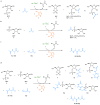Harnessing chemical energy for the activation and joining of prebiotic building blocks
- PMID: 33093680
- PMCID: PMC7610406
- DOI: 10.1038/s41557-020-00564-3
Harnessing chemical energy for the activation and joining of prebiotic building blocks
Erratum in
-
Publisher Correction: Harnessing chemical energy for the activation and joining of prebiotic building blocks.Nat Chem. 2021 Jan;13(1):99. doi: 10.1038/s41557-020-00591-0. Nat Chem. 2021. PMID: 33208896 No abstract available.
Abstract
Life is an out-of-equilibrium system sustained by a continuous supply of energy. In extant biology, the generation of the primary energy currency, adenosine 5'-triphosphate and its use in the synthesis of biomolecules require enzymes. Before their emergence, alternative energy sources, perhaps assisted by simple catalysts, must have mediated the activation of carboxylates and phosphates for condensation reactions. Here, we show that the chemical energy inherent to isonitriles can be harnessed to activate nucleoside phosphates and carboxylic acids through catalysis by acid and 4,5-dicyanoimidazole under mild aqueous conditions. Simultaneous activation of carboxylates and phosphates provides multiple pathways for the generation of reactive intermediates, including mixed carboxylic acid-phosphoric acid anhydrides, for the synthesis of peptidyl-RNAs, peptides, RNA oligomers and primordial phospholipids. Our results indicate that unified prebiotic activation chemistry could have enabled the joining of building blocks in aqueous solution from a common pool and enabled the progression of a system towards higher complexity, foreshadowing today's encapsulated peptide-nucleic acid system.
Conflict of interest statement
The authors declare no competing interests.
Figures


Comment in
-
Prebiotic metabolism gets a boost.Nat Chem. 2020 Nov;12(11):982-985. doi: 10.1038/s41557-020-00567-0. Nat Chem. 2020. PMID: 33093678 No abstract available.
References
-
- Verlander MS, Lohrmann R, Orgel LE. Catalysts for the self-polymerization of adenosine cyclic 2’,3’-phosphate. J Mol Evol. 1973;2:303–316. - PubMed
-
- Lambert J-F. Adsorption and Polymerization of Amino Acids on Mineral Surfaces: A Review. Orig Life Evol Biosph. 2008;38:211–242. - PubMed
-
- Kanavarioti A, Monnard P-A, Deamer DW. Eutectic phase in ice facilitate nonenzymatic nucleic acid synthesis. Astrobiology. 2001;1:271–281. - PubMed
-
- Canavelli P, Islam S, Powner M. Peptide ligation by chemoselective aminonitrile coupling in water. Nature. 2019;571:546–549. - PubMed
-
- Lohrmann R, Orgel LE. Prebiotic synthesis: phosphorylation in aqueous solution. Science. 1968;161:64–66. - PubMed
Publication types
MeSH terms
Substances
Grants and funding
LinkOut - more resources
Full Text Sources

